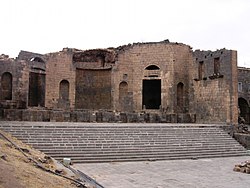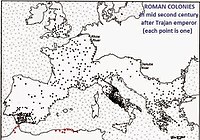Shahba
Shahba شهبا Philippopolis | |
|---|---|
 The Philippeion, a memorial monument | |
 Shahba Location in Syria | |
Coordinates: 32°51′15″N 36°37′45″E / 32.85417°N 36.62917°E / 32.85417; 36.62917 | |
| Country | |
| Governorate | As-Suwayda Governorate |
| District | Shahba District |
| Population (2004) | |
| • Total | 14,784 |
| Time zone | EEST |
Shahba (Arabic: شهبا / ALA-LC: Shahbā) is a city located 87 km south of Damascus in the Jabal el Druze in As-Suwayda Governorate of Syria, but formerly in the Roman province of Arabia Petraea. Known in Late Antiquity as Philippopolis (in Arabia), the city was the seat of a Bishopric (see below), which remains a Latin titular see.
Contents
1 History
1.1 Roman history
1.2 Ottoman rule and later
1.3 Modern Era
2 Ecclesiastical history
2.1 Titular see
3 Climate
4 See also
5 References
6 Sources and external links
History
Roman history

The Roman Theatre at Shahba
The oasis settlement now named Shahba had been the native hamlet of the Roman emperor Philip the Arab. After Philip became emperor in 244 CE, he dedicated himself to rebuilding the little community as a colonia. The contemporary community that was replaced with the new construction was so insignificant that one author states that the city can be considered to have been built on virgin soil, making it the last of the Roman cities founded in the East.[1]

Mosaic from Shahba depicting Aphrodite and Ares
The city was renamed Philippopolis (a name with homonyms) in dedication to the emperor, who is said to have wanted to turn his native city into a replica of Rome herself.[citation needed] A hexagonal-style temple and an open-air place of worship of local style, called a kalybe, a triumphal arch, baths, a starkly unornamented theatre faced with basalt blocks,[2] a large structure that has been interpreted as a basilica, and the Philippeion (illustration, right) surrounded by a great wall with ceremonial gates,[3] were laid out and built following the grid plan of a typical Roman city.
The public structures formed what author Arthur Segal has called a kind of "imported façade". The rest of the urban architecture was modest and vernacular.[4] The city was never completed as building seems to have stopped abruptly after the death of Philip in 249.
The new city followed the extremely regular Roman grid-plan, with the main colonnaded cardo maximus intersecting a colonnaded decumanus maximus at right angles near the center. Lesser streets marked off insulae, many of which never saw houses constructed upon them.
Ottoman rule and later
In 1596 Shahba appeared in the Ottoman tax registers as Sahba and was part of the nahiya of Bani Miglad in the Qada of Hauran. It had an entirely Muslim population consisting of 8 households and 3 bachelors, who paid taxes on wheat, barley, summer crops, goats and/or beehives.[5]
Because it was far from population centers that would have required cut stone for building and might have quarried it from those deserted in Philippopolis, Shahba today contains well-preserved ruins of the ancient Roman city.
A museum located in the city exhibits some beautiful examples of Roman mosaics.[6] The especially rich iconography of the figurative mosaic on the theme, The Glory of the Earth, discovered in 1952 in the so-called "Maison Aoua", is conserved today in the museum of Damascus and has proved a rich resource for iconographers.[7]
The relatively well-preserved Roman bridge at Nimreh is located in the vicinity.
Modern Era
In the 18th century Druze populations moved into the area.[8] A Christian presence exists in the city to the present.[9]
Ecclesiastical history
Circa 300, the city became the suffragan diocese of the Metropolitan Archdiocese of Bostra (now Bosra), capital of their Roman province of Arabia Petraea (civil Diocese of Oriens]), in the sway of the Patriarchate of Antioch. It is still mentioned as such in a 6th century Byzantine Notitia Episcopatuum.
Two bishops are historically documented:[10]
- Hormisdas intervened at the Council of Chalcedon in 451
- Basilius, in 553 on an inscription. [3].
Titular see
Circa 1000, being truly in partibus infidelium under Muslim rule, it was suppressed as residential see but nominally retained (or later restored?) as Latin Titular bishopric of Philippopolis (Latin) / Filippopoli (Curiate Italian; in 1926 renamed Filippopoli d’Arabia). In 1933 it was renamed Philippopolis in Arabia (Latin) / Filippopoli di Arabia (Italian) / Philippopolitan(us) in Arabia (Latin adjective), avoiding possible confusion with Philippopolis in Thracia (now Bulgarian Plovdiv).
It is vacant since decades, having had the following incumbents, mostly of the fitting Episcopal (lowest) rank, with Archiepiscopal exceptions :
- Titular Archbishop: Henri de Villars (1652 – 1663.05.27) as Coadjutor Archbishop of Vienne (France) (1652 – 1663.05.27); next succeeded as Metropolitan Archbishop of Vienne (1663.05.27 – death 1693.12.27)
Troiano Acquaviva d’Aragona (1729.04.18 – 1730.08.14) as Prefect of Prefecture of the Holy Apostolic Palaces (1729.07.06 – ?); later promoted Titular Archbishop of Larissa (1730.08.14 – 1732.10.01), created Cardinal-Priest of Ss. Quirico e Giulitta (1732.11.17 – 1733.01.19), transferred Cardinal-Priest of S. Cecilia (1733.01.19 – death 1747.03.20), Metropolitan Archbishop of Monreale (Sicily, Italy) (1739.05.04 – 1747.03.20), Camerlengo of Sacred College of Cardinals (1744.02.03 – resigned 1745.01.25)- Giovanni Battista Giampè (1740.12.19 – 1764.05.10), without actual prelature
- José Tomás Mazarrasa y Rivas (1885.02.21 – death 1907.03.11) as Apostolic Administrator of Diocese of Ciudad Rodrigo (Spain) (1885.03.27 – 1907.03.11)
- George Gauthier (1912.06.28 – 1923.04.05) as Auxiliary Bishop of Archdiocese of Montréal (Quebec, Canada) (1912.06.28 – 1923.04.05) and Apostolic Administrator of Montréal (1921.10.18 – 1939.09.20); next promoted Titular Archbishop of Tharona (1923.04.05 – 1939.09.20) as Coadjutor Archbishop of Montréal (1923.04.05 – 1939.09.20), succeeding as Metropolitan Archbishop of Montréal (1939.09.20 – death 1940.08.31)
- Titular Archbishop: Ignacy Maria Dubowski (Lithuanian) (1925.06.01 – death 1953.03.10) as emeritate (and promotion); previously Apostolic Administrator of Diocese of Kamyanets-Podilsky (Ukraine) (1916.10.16 – 1918) and Bishop of Lutsk and Zytomierz (Ukraine) (1916.10.16 – 1925.06.01)
- Antonio Ravagli (1955.07.04 – 1960.08.30) as Coadjutor Bishop of Larino (Italy) (1955.07.04 – 1959) and as Coadjutor Bishop of Modigliana (Italy) (1959 – 1960.08.30); next succeeded as Bishop of Modigliana (1960.08.30 – 1970.04.30), also Auxiliary Bishop of Faenza (Italy) (1967 – 1970.04.30), then Titular Bishop of Montecorvino (1970.04.30 – 1981.12.14) as Auxiliary Bishop of Archdiocese of Firenze (Florence, Italy) (1970.04.30 – death 1981.12.14)
Giovanni Colombo (1960.10.25 – 1963.08.10) as Auxiliary Bishop of Milano (Milan, Italy) (1960.10.25 – 1963.08.10); next succeeded as Metropolitan Archbishop of Milano (1963.08.10 – retired 1979.12.29), created Cardinal-Priest of Ss. Silvestro e Martino ai Monti (1965.02.25 – death 1992.05.20).
Climate
| Climate data for Shahba | |||||||||||||
|---|---|---|---|---|---|---|---|---|---|---|---|---|---|
| Month | Jan | Feb | Mar | Apr | May | Jun | Jul | Aug | Sep | Oct | Nov | Dec | Year |
| Average high °C (°F) | 10.3 (50.5) | 11.6 (52.9) | 15.2 (59.4) | 20.1 (68.2) | 25.6 (78.1) | 29.4 (84.9) | 30.7 (87.3) | 31.2 (88.2) | 29.3 (84.7) | 25.9 (78.6) | 18.8 (65.8) | 12.5 (54.5) | 21.7 (71.1) |
| Average low °C (°F) | 1.3 (34.3) | 2.2 (36) | 4.4 (39.9) | 7.6 (45.7) | 11.2 (52.2) | 14.1 (57.4) | 15.7 (60.3) | 15.9 (60.6) | 14.0 (57.2) | 11.3 (52.3) | 7.4 (45.3) | 3.4 (38.1) | 9 (48.3) |
| Average precipitation mm (inches) | 61 (2.4) | 60 (2.36) | 46 (1.81) | 18 (0.71) | 9 (0.35) | 0 (0) | 0 (0) | 0 (0) | 1 (0.04) | 11 (0.43) | 26 (1.02) | 53 (2.09) | 285 (11.22) |
| Source: [Climate data] | |||||||||||||
See also
- List of Catholic dioceses in Syria
References
^ Arthur Segal, "Roman Cities in the Province of Arabia" The Journal of the Society of Architectural Historians 40.2 (May 1981:108-121) p. 111.
^ This, the last of the Syrian theatres, was examined in a detailed monograph by Pierre Coupel and Edmond Frézouls, Le Théâtre de Philippopolis en Arabie (Paris, 1956); an extended review by John Eames in The Journal of Roman Studies 50.1/2 (1960:273-274) serves as an abstract of it.
^ Nabatean capitals at the southern gate documented the continuing cultural influence of Nabateans in the region, long after their political influence succumbed to Roman hegemony (Segal 1981:118).
^ Segal 1981:108; the architectural vocabulary of Philippopolis is discussed in pages.
^ Hütteroth and Abdulfattah, 1977, p. 218.
^ Philipapolis [sic], Syra
^ The literature is summarized in Marie-Henriette Quet, "Le Triptolème de la mosaïque dite d'Aiôn et l'affirmation identitaire héllène à Shahba-Philippopolis" Syria 77 (2000), pp. 181-200
^ Philippopolis in Arabia at Catholic-Hierarchy.org
^ https://zenit.org/articles/in-shadow-of-war-syrian-christians-are-trying-to-rebuild-their-lives/
^ Echos d'Orient, vol. XII, 1909, 103 & vol. X, 1907, pp. 95 e 145
Sources and external links
| Wikimedia Commons has media related to Shahba. |
- GCatholic - (former &) titular bishopric
Map of the town, Google Maps
- Bibliography
- Pius Bonifacius Gams, Series episcoporum Ecclesiae Catholicae, Leipzig 1931, p. 435
- Konrad Eubel, Hierarchia Catholica Medii Aevi, vol. 2, p. 215; vol. 3, p. 273; vol. 4, p. 280; vol. 5, p. 314; vol. 6, p. 337
- Michel Lequien, Oriens christianus in quatuor Patriarchatus digestus, Paris 1740, vol. II, coll. 861-862
.mw-parser-output .refbeginfont-size:90%;margin-bottom:0.5em.mw-parser-output .refbegin-hanging-indents>ullist-style-type:none;margin-left:0.mw-parser-output .refbegin-hanging-indents>ul>li,.mw-parser-output .refbegin-hanging-indents>dl>ddmargin-left:0;padding-left:3.2em;text-indent:-3.2em;list-style:none.mw-parser-output .refbegin-100font-size:100%
Hütteroth, Wolf-Dieter; Abdulfattah, Kamal (1977). Historical Geography of Palestine, Transjordan and Southern Syria in the Late 16th Century. Erlanger Geographische Arbeiten, Sonderband 5. Erlangen, Germany: Vorstand der Fränkischen Geographischen Gesellschaft. ISBN 3-920405-41-2..mw-parser-output cite.citationfont-style:inherit.mw-parser-output qquotes:"""""""'""'".mw-parser-output code.cs1-codecolor:inherit;background:inherit;border:inherit;padding:inherit.mw-parser-output .cs1-lock-free abackground:url("//upload.wikimedia.org/wikipedia/commons/thumb/6/65/Lock-green.svg/9px-Lock-green.svg.png")no-repeat;background-position:right .1em center.mw-parser-output .cs1-lock-limited a,.mw-parser-output .cs1-lock-registration abackground:url("//upload.wikimedia.org/wikipedia/commons/thumb/d/d6/Lock-gray-alt-2.svg/9px-Lock-gray-alt-2.svg.png")no-repeat;background-position:right .1em center.mw-parser-output .cs1-lock-subscription abackground:url("//upload.wikimedia.org/wikipedia/commons/thumb/a/aa/Lock-red-alt-2.svg/9px-Lock-red-alt-2.svg.png")no-repeat;background-position:right .1em center.mw-parser-output .cs1-subscription,.mw-parser-output .cs1-registrationcolor:#555.mw-parser-output .cs1-subscription span,.mw-parser-output .cs1-registration spanborder-bottom:1px dotted;cursor:help.mw-parser-output .cs1-hidden-errordisplay:none;font-size:100%.mw-parser-output .cs1-visible-errorfont-size:100%.mw-parser-output .cs1-subscription,.mw-parser-output .cs1-registration,.mw-parser-output .cs1-formatfont-size:95%.mw-parser-output .cs1-kern-left,.mw-parser-output .cs1-kern-wl-leftpadding-left:0.2em.mw-parser-output .cs1-kern-right,.mw-parser-output .cs1-kern-wl-rightpadding-right:0.2em
Coordinates: 32°51′15″N 36°37′45″E / 32.85417°N 36.62917°E / 32.85417; 36.62917

 Clash Royale CLAN TAG#URR8PPP
Clash Royale CLAN TAG#URR8PPP


